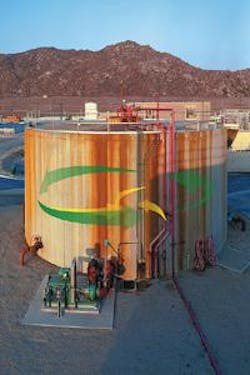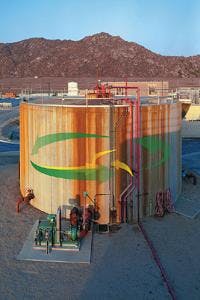Small Town Develops Strategy to Counter Drought
By Richard A. Terselic
Thurmont is located in north-central Maryland, at the foot of the Catoctin chain of the Appalachian Mountains. During the 1980s and '90s the town developed rapidly, more than doubling its population to the current level of 5700. EPA's increased demands related to purification of surface water sources prompted the town to become dependent on a covered cistern, fed by a mountain stream, and its municipal wells.
Thurmont shared the impact of the prolonged drought that the Northeast U.S. experienced in the late '90s and early 2000s. While well levels progressively declined, production and quality was not materially affected until Christmas Day, 2001, when Thurmont Water Superintendent Gary W. Dingle noted production of muddy water for the first time. While he was able to correct the problem by lowering the pumping rate, in the course of doing so he noted an important drop in the well levels.
Dingle informed the town's elected Board of Commissioners of the problem and offered his judgment that prompt action was needed to assure that the system could be depended upon for an adequate supply of high quality water. The problem that Thurmont was beginning to experience was shared by other nearby communities that operated municipal systems, as well as residents that relied on private wells.
The Commissioners recognized the gravity of the problem and the need to devise options for addressing the threat it posed. Their first actions involved asking water users to curtail all but essential use, and imposing restrictions on the largest commercial users (that were initially believed to be the town's two auto washes and two laundromats.) While the four businesses agreed, and restricted their hours of operation, they questioned whether it was appropriate to limit such action to them, absent data on usage by all businesses.
A list was compiled of the town's 30 largest users that showed the initial presumption was in error. The largest users were actually the town's restaurants, motels, schools and factories. The larger of the town's laundromats placed fifth in the "Top 30" listing but the second was not present. The two auto washes placed sixteenth and seventeenth.
The winter of 2001-2 was unusually dry and the Commissioners concluded that a more vigorous, broadly based approach would have to be developed to address the worsening well level situation. Emergency restrictions were enacted on specific types of water usage, such as vehicle washing and garden watering, and large business and commercial users were asked to prepare and file with the town conservation plans that provided for increasing percentages of reduction in use.
Thurmont has a long tradition of citizen participation in the work of government and the Commissioners also invited volunteers to participate in a Citizens Water Conservation Committee. It would be chaired by the Commissioner who oversaw the town's water and sewer activities.
On April 29, 2002, the committee met for the first time. It's membership included individual citizens and representatives of local businesses. The Water Superintendent participated as a technical advisor. The committee initially divided into two working groups, one focusing on developing a revised water ordinance and related policy, and a second focusing on conservation ideas.
Both groups began their work by searching for relevant information. They contacted nearby communities that were also grappling with the water shortage issue, sources on the web, and elsewhere. Substantial amounts of information were quickly accumulated, in fact, more than could be quickly evaluated and absorbed. The committee met on a weekly basis and over the months that followed, several products resulted - that will be listed and briefly described.
Water Shortage Policy Statement and Revised Water Ordinance
The approach adopted to setting policy and devising enforceable conditions was incorporated in two related documents. The first, an administrative policy document, established four shortage stages tied to well levels, and provided a simple procedure for declaring and changing stages. The second, a revision of the existing water ordinance, listed increasing, stage-specific demands for conservation actions that were tied to enforceable penalties for violation.
The policy document provided means for declaration of the appropriate stage, and this, in turn, influenced the level of restrictions of water use that would apply. For example, movement from Stage 2 to 3 would, among other specified restrictions, result in a halt on issuance of new zoning certificates (the equivalent of town building permits) that had the potential for increasing the demand for water. The ordinance also clarified the status of violations of the restrictions, and increased the financial penalties.
The first revision of the ordinance became law on July 23, 2002. While considerable thought went into the drafting of the ordinance in consultation with the town's attorney, early experience prompted enactment of two, "fine tuning" amendments. For example, the issue arose as to whether the town could restrict the transporting of municipal water for uses outside the town's service area. The curtailing of zoning certificates also produced numerous appeals for exemptions from builders and homeowners who wished to complete additions or remodeling projects.
Public Communications
Weekly meetings of the Board of Commissioners are televised locally. Presentations by the Water Superintendent were included as a regular agenda item to hear reports on the status of well levels and other water-related topics, such as the search for new water sources.
The Citizen's Committee also developed the first (in a planned series) of Water Conservation Newsletters. This first issue, dated May 2002, presented four pages of news and conservation suggestions. It was mailed to each of the town's water accounts.
Additional Water Sources
With the help of aerial photographs, and the consulting geologist with whom the town has a continuing relationship, a search was initiated for new water sources. High interest candidate locations became the subjects for exploratory drilling. Attention was also directed to evaluating whether the municipal well that had been abandoned two decades earlier due to gasoline contamination could be returned to service. Also, an existing, low volume well was returned to service.
Water Conservation
Several conservation-related initiatives were developed and pursued by the Committee with the encouragement of the Commissioners, including:
•Revision of Water Statements to Include Historical Use Data
The Committee learned that a nearby community included bar graph format data on the current and previous four quarters of water use within it's bills. This provided an easy to read means of tracking the success of conservation efforts by users. Thurmont town staff revised the computerized billing format to include the same amount of data, but simply in numerical rather than bar graph format.
•Posting of Water Stage Signs
As a part of the ongoing effort to keep residents alert to the current stage of water restriction, it was agreed to acquire and post signs at the main entrances to the town that would indicate the current stage of water restriction. Each stage was assigned a color: green (normal); yellow (watch); orange (warning) and red (emergency). The design of the signs will permit color inserts to be changed to coincide with changes in stage.
•Monitoring for Water Supply System Leaks
Thurmont is a very old town, and some of the older sections of the water supply system are susceptible to leakage. While a continuing program is operated to replace the lines in these older sections, a heightened level of surveillance was implemented to locate and correct leaks. As a product of this effort, a major fresh water leak was identified at the town's sewerage processing facility. This facility is a major user of fresh water.
•Designation of a Water Conservation Officer
To assure that a single point of responsibility exists within town government related to water conservation initiatives, the Water Superintendent was assigned this role as an added duty.
•Upgrading of Water Account Meters
The town operates a program to replace water meters on a cyclic basis. As a new initiative, it was decided to conduct a trial involving the installation of a number of electronic meters. It is expected that these meters will be more accurate and durable than the mechanical meters they will replace. The new meters have the added benefit that they can be read electronically and the readings stored in a hand held device that can be downloaded directly to the town's computerized billing system. It is hoped that this will speed, and make more accurate, meter reading and data entry.
•Distribution of Water Savings Device Kits
The town purchased 1000 water savings device kits for distribution to water system customers, without charge. The kits contain several conservation-related items, including: toilet leak detection dye tablets, a toilet water displacement bag, and flow restricting washers for installation in shower heads and faucets. Plans call for enlisting a local public service group to do a door-to-door distribution of the kits in the older sections of the town. Local plumbers also were asked whether they would be willing to install the kits for persons unable to do so on their own. One indicated it's willingness, and volunteered a 10% discount from their normal hourly rate.
Water Saving Device Incentive Credit Program
To encourage the permanent installation of water saving devices, the Commissioners authorized a trial program in which credits will be granted to residential and commercial water users who install water saving devices, including; low flow rate shower heads, 1.6 gallon per flush toilets and EPA "Energy Star" rated, front loading clothes washers (that use less water and electricity per cycle.) Residential accounts can receive up to $500 in credits and commercial accounts up to $1000. The credits are applied to current and future water charges.
Initiatives Considered But Not Adopted
As a part of an attempt to comprehensively address the water supply problem and encourage conservation, a wide range of initiatives was considered for adoption. However, consensus was not reached regarding the feasibility or the likelihood of public acceptance of some of these initiatives. Among those rejected were:
• revising the current quarterly meter reading and billing cycle to one in which a third of the town would be read and billed each month. The objective was to provide a better opportunity to monitor for unusually high usage situations.
• adopting a progressive water pricing structure, to replace the current flat rate. The objective was to provide a financial incentive for conserving.
• reducing the pressure at which water is supplied (to reduce loss related to unrecognized leaks.)
— assuming public responsibility for the section of supply lines between the meter and the service entrance to a user's facility (to provide for better control of leakage situations in that section of line.)
Conclusion
Shortly before this article was written, the town well levels had risen enough (with the assistance of a record winter snowfall and numerous heavy rains) to permit declaring a "normal" stage green. In returning to the "normal" stage, and removing restrictions, it is hoped that Thurmont water users will not quickly forget the importance of practicing conservation measures. Two new high producing wells have been drilled and the town is now working with state officials to establish the acceptable pumping level for the first well.
About the Author: Richard Terselic is a Mechanical Engineering graduate of the Case-Western Reserve University, and a Public Administration graduate of the University of Michigan. He began his 35 years of service with the federal government in 1959 working with NASA and ended it with the Food and Drug Administration in 1993. He has published numerous articles in scientific and management publications and also taught at both undergraduate and graduate levels. Since moving to Thurmont, he has been an observer of town government and a volunteer participant in citizen support groups.
